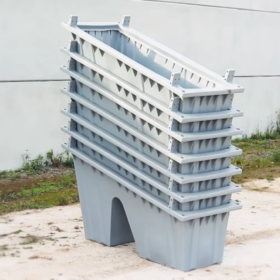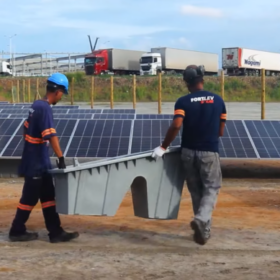From pv magazine Brazil
Brazil-based Fortlev Solar has developed Lastro Solar, a patented polyethylene mounting structure for ground-mounted PV plants.
Eduardo Nascimento. Fortlev Solar's engineering manager, claimed that the technology can cut assembly times by 50% compared to metal-only structures.
“If compared to a metal-only structure, the Lastro Solar can reduce the assembly time by 50%,” Nascimento told pv magazine. “For example, the average installation time of a 100 kW array, with 185 modules, is 14 days. With Lastro Solar, this time is reduced to half of the time.”
Nascimento said that for a 100 kW array with 185 modules, the average installation time of 14 days can be halved with Lastro Solar's tech. The product weighs 15 kg, can be equipped with a tilt adjustment system, and is best suited for clear and rugged terrain.
The structure's mobility allows for relocating solar panels, offering flexibility in a dynamic business environment. Lastro Solar is constructed entirely from 100% polyethylene, a material used in Fortlev's water tank production. With over 30 years of experience in the market, Fortlev Solar aims to expand the accessibility of solar applications in Brazil.
The engineer in charge of creating Lastro Solar, Maurício Ouriques, said he tried to design a straightforward product that would be easy for anyone to install, by simplifying the process for customers as much as possible.
“Fortlev is one of the main manufacturers of water tanks in Brazil, which makes us specialists in the production of thermoplastics,” said Ouriques. “We are not adventuring. We believe in a quality product with the credibility that our group offers.”
This content is protected by copyright and may not be reused. If you want to cooperate with us and would like to reuse some of our content, please contact: editors@pv-magazine.com.





By submitting this form you agree to pv magazine using your data for the purposes of publishing your comment.
Your personal data will only be disclosed or otherwise transmitted to third parties for the purposes of spam filtering or if this is necessary for technical maintenance of the website. Any other transfer to third parties will not take place unless this is justified on the basis of applicable data protection regulations or if pv magazine is legally obliged to do so.
You may revoke this consent at any time with effect for the future, in which case your personal data will be deleted immediately. Otherwise, your data will be deleted if pv magazine has processed your request or the purpose of data storage is fulfilled.
Further information on data privacy can be found in our Data Protection Policy.